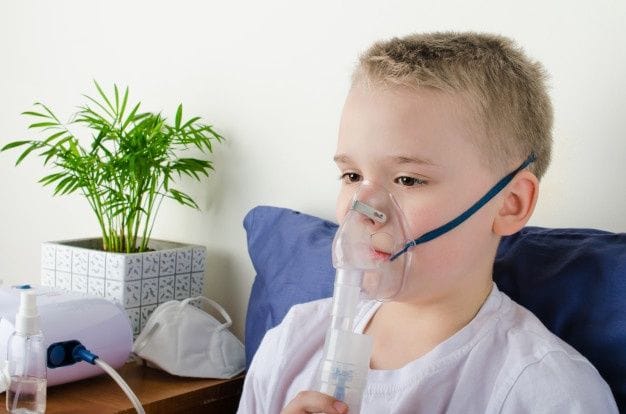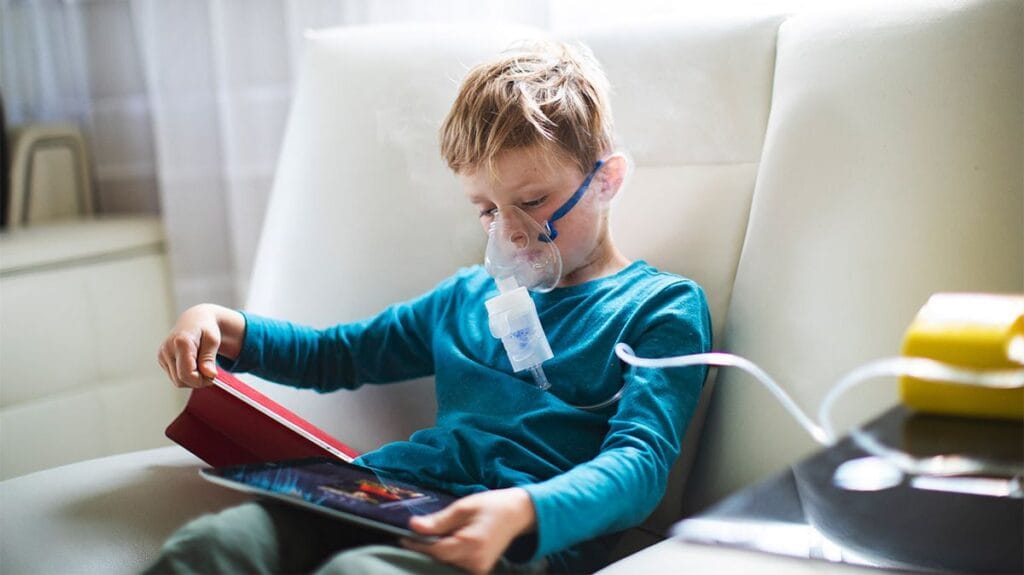When your child struggles to breathe, every second feels like a lifetime. That’s where a nebulizer for children becomes a true lifesaver. Designed with little lungs in mind, a pediatric nebulizer gently turns liquid medicine into a fine mist, helping your baby, infant, or toddler breathe more easily. Whether at home or on the go. From choosing the right device to learning how to fit a comfy mask, this guide walks you through everything you need to make treatment time feel safe, smooth, and even a little magical.
Understanding Pediatric Nebulizer Therapy
Treating breathing issues in children often requires more than just a simple inhaler. In many cases, a nebulizer becomes essential, especially when managing childhood asthma or other respiratory disorders. A pediatric nebulizer turns liquid medicine into a fine mist, helping your child breathe more easily. These devices are commonly used in children’s hospitals, but they are also safe for home use under the guidance of a health care provider.
What Is a Pediatric Nebulizer Device?
A pediatric nebulizer is a device used to deliver asthma medicine or other medications directly to the lungs of your child. It works by using a compressor machine and tubing to push air through a nebulizer cup filled with liquid medication, creating a mist the child can inhale. Most models include a mask or mouthpiece to ensure the medicine reaches deep into the lungs.
Did you know some portable nebulizers for kids are small enough to fit in your pocket?
How a Nebulizer Helps a Child Breathe
The nebulizer turns medication into an easy-to-inhale mist, making it ideal for infants, young children, and kids who can’t use a metered dose inhaler. It delivers treatment slowly over 10 to 15 minutes while the child sits upright. This helps relieve symptoms like wheezing, cough, and difficulty breathing, especially during asthma attacks.
Differences Between Nebulizers and Inhalers
While both inhalers and nebulizers deliver asthma medicine, they work differently. Inhalers are compact and quick but require coordination, which some children may struggle with. A nebulizer machine offers longer, hands-free treatment, making it more suitable for babies and children under 6 years old who can’t yet inhale through a mouthpiece properly.
Preparing the Nebulizer Machine

Before you use a nebulizer, proper setup is key to effective treatment. Whether you’re using a jet nebulizer or a portable nebulizer for kids, assembling the components correctly ensures safe and smooth therapy sessions.
Setting Up the Nebulizer Cup and Tubing
Start by washing your hands, then connect the tubing from the compressor to the nebulizer cup. Pour the prescribed liquid medicine into the cup, making sure the dosage is accurate. Attach the mouthpiece or mask, depending on your child’s age and ability to cooperate.
Did you know the first nebulizer device was invented over a century ago, and it’s helped millions of children breathe better since?
Choosing the Right Mask or Mouthpiece
For infants and very young children, a facemask is often best, covering both the mouth and nose to ensure a tight seal. Older kids may prefer a mouthpiece, which can deliver the mist more directly to the lungs. The right fit improves nebulizer performance and reduces wasted aerosol.
Using Accessories for Better Nebulizer Performance
Using a holding chamber, clean filters, and compatible accessories enhances the nebulizer performance. Always ensure that the nebulizer set is correctly assembled and that the air compressor works efficiently. A well-maintained device supports consistent treatment and helps your child breathe better.
Read also Digital Smile Design
How to Use a Nebulizer for Children
Using a nebulizer with your child doesn’t have to be stressful. With some preparation and patience, you can turn treatment time into a calm, effective routine.
Steps to Use a Nebulizer for Your Baby or Infant
Position your baby or infant in an upright position, preferably sitting in your lap. Attach the facemask securely and turn the machine on. Let your little one inhale the misty medicine until the nebulizer cup is empty, which usually takes about 10–15 minutes.
Tips for Comfort and Proper Mist Delivery
Help your child relax by reading a story or playing calming music. Make sure the mask or mouthpiece stays in place, allowing the mist to reach the lungs. Encourage slow, deep breaths and reassure your child throughout the process.
Ensuring Effective Aerosol Treatment
To ensure effective aerosol treatment, always follow the full prescribed dose and cleaning routine. Avoid interrupting the session, and allow the child to finish the full treatment. Assess if the nebulizer is producing a strong mist—if not, check the accessories or ask your health care provider.
Did you know a baby nebulizer can deliver aerosol medicine even while the infant sleeps?
Choosing the Right Nebulizer for Kids

Selecting the right nebulizer is crucial for reliable and comfortable treatment. Depending on your child’s age, routine, and medical needs, you may choose from several nebulizer types.
Comparing Jet Nebulizers and Handheld Devices
Jet nebulizers use compressed air and are great for home use, while handheld or battery-powered models are more convenient for travel. Both types can effectively deliver medicine, but jet nebulizers tend to have longer treatment time.
When to Use a Portable Nebulizer for Kids
A portable nebulizer for kids is useful for school, vacations, or busy schedules. It’s lightweight and quiet, making it easier to use the nebulizer on the go. Make sure the model you choose is pediatric-friendly and approved by your health care provider.
Selecting the Best Nebulizer Set for Home Use
Look for a nebulizer set that includes a compressor, chamber, tubing, mask, and mouthpiece. Brands that offer good accessory options and proven performance are ideal. Remember, a well-chosen device simplifies routine treatments and helps manage your child’s asthma effectively.
Read about Scars Laser Treatment
Common Conditions and Nebulizer Treatment
Many children use nebulizers as part of their regular respiratory care. These devices help manage both acute and chronic conditions that affect your child’s lungs.
Using a Nebulizer for Pediatric Asthma
One of the most common reasons to use a nebulizer is for treating pediatric asthma. A nebulizer can quickly deliver asthma medicine to open airways, helping your child breathe easier during a flare-up. It’s often used as a first line of treatment options.
Treating Respiratory Infections with a Nebulizer
For respiratory infections, such as bronchiolitis, a nebulizer can deliver medication that reduces inflammation and clears mucus. This helps alleviate coughing and shortness of breath, especially in young children who struggle to breathe when sick.
How a Nebulizer Supports Infant Breathing Therapy
For infants, a nebulizer offers gentle and effective treatment when other devices may be too complex. It helps infants with asthma, infections, or other lung conditions by delivering medication directly into their airways.
Safety, Cleaning, and Maintenance
Maintaining your nebulizer machine is essential for your child’s safety. A clean device ensures optimal performance and prevents infection.
How to Clean the Nebulizer Machine and Accessories
After each use, rinse the nebulizer cup, mask, and mouthpiece with warm water. Once daily, wash them with mild soap, rinse, and air-dry. Always clean the mouthpiece properly to avoid bacteria buildup.
Storing the Holding Chamber and Compressor Safely
Store the holding chamber, compressor, and other parts in a clean, dry container. Keep everything out of your child’s reach and avoid humid areas. A well-kept machine lasts longer and supports safer treatments.
Avoiding Misty Build-Up and Ensuring Device Hygiene
If you notice misty residue or weaker mist, inspect the filters and tubing. Replace worn-out parts and follow a routine cleaning schedule. A hygienic nebulizer delivers better results and helps your child feel better faster.
Frequently Asked Questions about Nebulizer for Children
Which nebulizer is best for children?
The best pediatric nebulizer combines comfort, reliability, and strong nebulizer performance. A portable nebulizer for kids is ideal for flexibility, while a jet nebulizer offers powerful delivery at home. Look for a complete nebulizer set with mask, tubing, cup, and quiet machine suited for your child’s age.
Is it good to use nebulizer for kids?
Yes, using a nebulizer is safe and effective for kids, especially those with asthma or respiratory issues. It gently delivers medicine as mist through a mask or mouthpiece, making it easier for children and infants to inhale compared to inhalers or pills.
At what age can a child use a nebulizer?
A nebulizer can be used from infancy. Even a baby can benefit with a soft mask designed for their size. Most pediatric nebulizers come with infant-friendly accessories and low-noise devices that support treatment from birth, under a doctor’s guidance.
Helping your child breathe better doesn’t have to be scary or confusing. With the right nebulizer machine, some patience, and a cozy spot on the couch, you can turn every treatment into a calm moment of care. Have you found a pediatric nebulizer that works best for your little one? Share your tips and let’s help more parents navigate this with confidence!